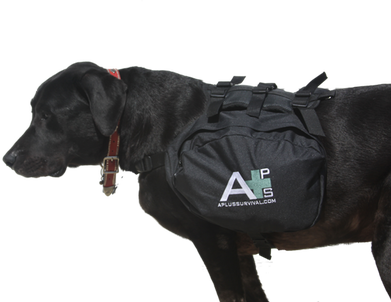How To Build Your Pets Emergency Kit
 Emergency kits should be build in three different sizes, Home, Car and Grab n Go! Each size containing your pets' basic survival needs. Food, water, collar, ID tags and more. The only difference being that each size different quantities and the larger the kit the more and varying items you can add.
Emergency kits should be build in three different sizes, Home, Car and Grab n Go! Each size containing your pets' basic survival needs. Food, water, collar, ID tags and more. The only difference being that each size different quantities and the larger the kit the more and varying items you can add.Emma Zen as shown in the picture above is wearing her favorite emergency preparedness Grab n Go kit available online at A Plus Survival. We have also seen opened side packs that can be more versatile yet still make a great Grab n Go, Bubba Pack.
When it comes to building your kit may we suggest you print the information below or bookmark this page and visit us once a week. We all have good intentions but how many of us actually have our emergency kits built? So make it easy on yourself and don't try and do it all at once! Obtain the first item this week and then add to it once a week, we could each do that! In no time at all you will be more prepared than you ever thought you would be!
Your HOME Emergency Preparedness kit should contain:
- A two-week supply of food for each pet stored in airtight containers. This should be rotated at least twice a year to insure it is fresh, this also maintains that the food your pet is now eating is in their emergency kit. During a stressful situation is no time to add a change of food routine to your pets regimen. Remember a manual can opener if you feed canned food.
- A two-week supply of water for each pet (count on 1 gallon per pet per day). Do not store this in direct sunlight to prevent algae growth and do not store plastic containers directly on concrete as they will start to leach chemicals. This also should be rotated or you can purchase a water purifier chemical.
- A two-week supply of any medications taken by your animals. Remember to change out regularly so that you don’t have expired medications and to update when a pet goes on a new medication.
- A waterproof container or a plastic bag you could store inside a small dog or cat crate. Place inside each of the follow items;
--Each of your pet’s vaccination records - Include a copy of your pets emergency contact plan.
- Affix and Emergency Alert Sticker near your front and back doors so that emergency personnel will know to look for your pets if you while you are not at home.
- Learn your pets Comfort Zone!
- Remember to take special consideration for "exotic pets", in regards to temporary housing and their daily needs.
--Photos of your pet with your family as proof of ownership
--Medical and Micro-chip records
--Leash, harness and crate or carrier for each pet
--Pet’s favorite treats, chew toys, bedding, food & water dishes
--Remember litter, scoop & box for kitties
--Cash
CREDIT: The Emma Zen Foundation
